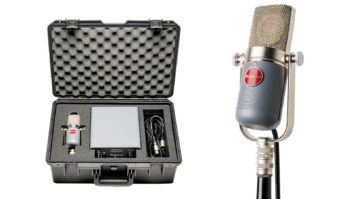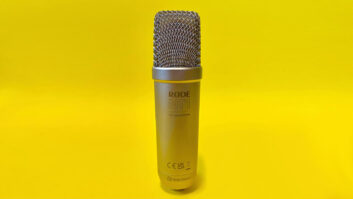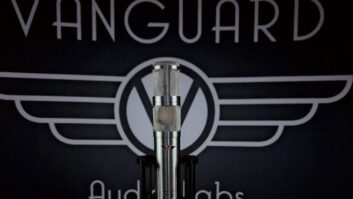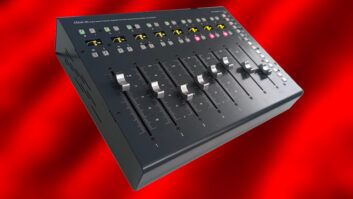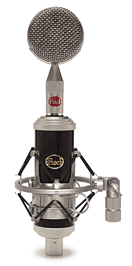
Red Microphones has released a number of products so far, including the Oktava MK-012 microphone preamplifier and the Red Lollipop large-diaphragm replacement capsule; the Type B solid-state mic; and the subject of this review, the Red Type A tube mic. The latter two take advantage of the Redhead Series — eight capsules that mount quickly using the familiar spring-loaded bayonet mount found in Blue’s high-end Bottle mics. The slender body houses a single ECC88 tube and ships in a sturdy red flight case housing up to three capsules, the mic body, power supply, cable and shock-mount.
TYPE A BEHAVIOR
I tested three capsules: the R0, R4 and R6. I began with the R6, which made the most sense on a vocal session. The literature characterizes this capsule as having a “modern presence vocal sound,” which is described as a brighter response with more proximity than Red’s other vocal capsule, the R7, and less high and low extension than the cardioid R0.
Used on an especially challenging male vocalist who has a particularly strident top end, the R6 nicely rounded the transients and harsh edge when the singer hit it hard. The result was a warm bottom end with a pleasant presence in the mix. This application was especially interesting, as after much experimentation (even with high-end mics), the best mic for this particular singer was the Shure SM7.
Up until now, the SM7 was the only mic that didn’t require surgical EQ and compression to keep this talented — albeit edgy — vocalist’s track from becoming an ice pick in your ear. For an A/B comparison, the first pass of the vocal was recorded using the SM7 and then a second pass was done with the Type A/R6 combo, with everything routed through an SSL 4000 G+ Series console’s preamps without EQ or compression. The consensus? The Type A had the effect of the dynamic mic, but with much more top end. Subsequently, it hit the reverb nicely and didn’t need added EQ at the top to compete with the rest of the track.
On another session, I used the R6 on another male vocal with equally good results. It was also used on an acoustic guitar placed about eight inches away from the front of the instrument at the top edge of the soundhole. The track exhibited plenty of top end with no LF boominess.
The big omni R4 capsule yielded poor results when used as a single overhead about 18 inches above a drum kit. It represented the cymbals harshly, making it my least favorite of the three capsules. Later, I tried it on the same session as a room mic, but it didn’t provide what I was looking for; it still sounded a bit harsh, although it exhibited plenty of nice bottom end from the kick.
On another drum kit, I tried the bright-sounding cardioid R0 capsule as a center overhead between a spaced pair of Blue Bottles fitted with B6 cardioid capsules. I was anxious to hear the difference between the mics because the Bottles are so much more expensive. I was pleasantly surprised when the trio worked together perfectly. The Bottles produced an extended top end as compared to the Type A (the chicken head knob on the Bottle power supply was positioned at 12 o’clock), but the R0 capsule represented the midrange frequencies nicely when I added the mic into the center of the mix. Even by itself, the Type A sounded great in mono, yielding plenty of punch from the toms and snare, and a smooth reproduction of the cymbals over the kit. The combination of the Bottles and R0 rocked my mix.
The R0 sounded killer on a Fender Deluxe combo amp with a Shure SM57. I placed the 57 up close while the Type A was positioned back about three feet away from the cabinet at a slight angle. The 57 captured all of the midrange frequencies that you would expect, offering a clean representation of the guitar amp, while the Type A added bottom end and a smooth top. This combination really filled out the guitar sound in the mix.
THAT’S A LOT OF COLOR!
My main complaint with this mic/capsule system is that you need a secret decoder ring — or the appropriate documentation — to discern the pattern of each of the eight capsules. Each is marked with only the designated number, R0 through R7, and nothing else. A company as creative as Blue (aka Red) could devise a more clever way to keep the user’s nose out of the manual and in the session.
That said, my overall experience was more than favorable. Out of the three capsules I tested, the R0 and R6 were exemplary, taming a vocalist whose pipes shot down even the most high-end mics. I loved the R0 as a center overhead between two Blue Bottles, while the R6 was absolutely beautiful on vocals and acoustic guitar. If you’re looking for a versatile, great-sounding mic system that can cover instruments and vocals alike, then the Red Type A just might be your ticket. Prices: Red Type A (without capsule), $1,345; R0, R1, R2, R3, R5, R6 and R7 capsules, $649 each; R4 capsule, $849.
Red Microphones, 818/206-8168, www.vintagemicrophone.com.
